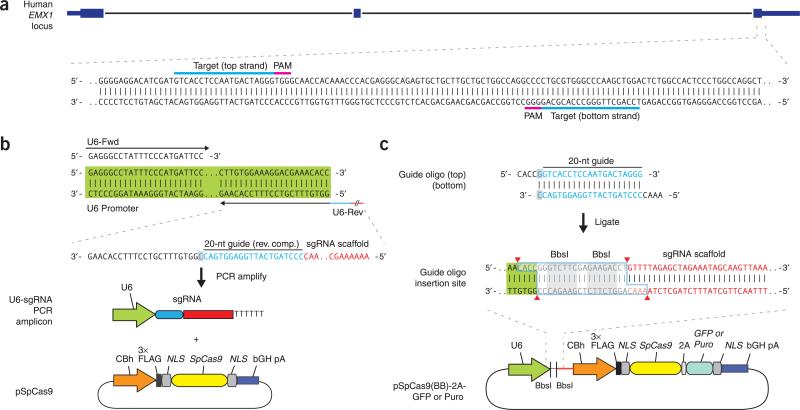Figure 4.
Target selection and reagent preparation. (a) For S. pyogenes Cas9, 20-bp targets (highlighted in blue) must be followed at their 3′ends by 5′-NGG, which can occur in either the top or the bottom strand of genomic DNA, as in the example from the human EMX1 gene. We recommend using the CRISPR Design Tool (http://tools.genome-engineering.org) to facilitate target selection. (b) Schematic for co-transfection of the Cas9 expression plasmid (pSpCas9) and a PCR-amplified U6-driven sgRNA expression cassette. By using a U6 promoter-containing PCR template and a fixed forward primer (U6-Fwd), sgRNA-encoding DNA can be appended onto the U6 reverse primer (U6-Rev) and synthesized as an extended DNA oligo (Ultramer oligos from IDT). Note that the guide sequence in the U6-Rev primer, designed against an example target from the top strand (blue), is the reverse complement of the 20-bp target sequence preceding the 5′-NGG PAM. An additional cytosine (‘C’ in gray rectangle) is appended in the reverse primer directly 3′ to the target sequence to allow guanine as the first base of the U6 transcript. (c) Schematic for scarless cloning of the guide sequence oligos into a plasmid containing Cas9 and the sgRNA scaffold (pSpCas9(BB)). The guide oligos for the top strand example (blue) contain overhangs for ligation into the pair of BbsI sites in pSpCas9(BB), with the top and bottom strand orientations matching those of the genomic target (i.e., the top oligo is the 20-bp sequence preceding 5′-NGG in genomic DNA). Digestion of pSpCas9(BB) with BbsI allows the replacement of the Type II restriction sites (blue outline) with direct insertion of annealed oligos. Likewise, a G-C base pair (gray rectangle) is added at the 5′ end of the guide sequence for U6 transcription, which does not adversely affect targeting efficiency. Alternate versions of pSpCas9(BB) also contain markers such as GFP or a puromycin resistance gene to aid the selection of transfected cells.

